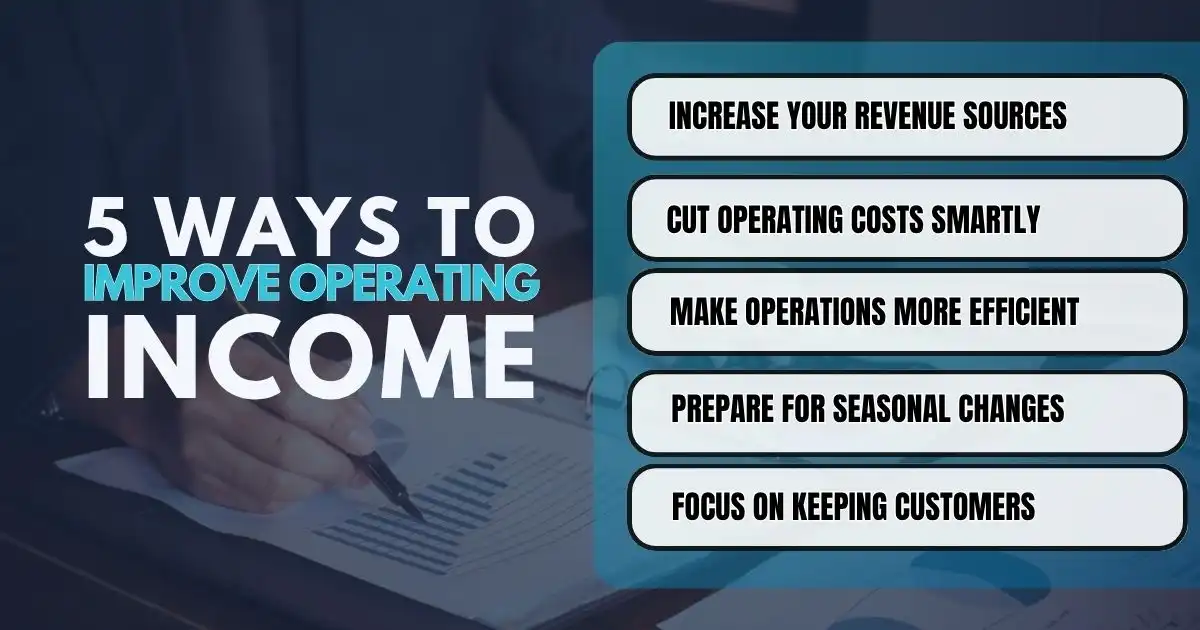When it comes to understanding how healthy a business is, operating income tells the true story. It shows how much money a company keeps from its everyday operations — not just from big sales or flashy one-time deals.
Smart business owners and investors don’t get distracted by quick wins or outside investments. Instead, they focus on operating income to judge how well a company runs at its core. It gets straight to the point: How much profit are you making from your regular business activities after covering the basic costs?
If you’re serious about measuring performance, planning smarter, and making better financial decisions, understanding operating income is important.
So, what exactly is operating income, and why does it matter so much?
What is Operating Income?

Operating income, also called operating profit, is the money a company makes from its sales after it pays for its regular business costs. These costs are called operating expenses and include anything needed to run the business day-to-day.
For example, buying paper for the office, paying rent, or hiring an accountant for taxes are all operating expenses.
Operating expenses also cover the Cost of Goods Sold (COGS). COGS is the money spent to make and sell products. This includes the cost of inventory, raw materials, workers’ wages, and marketing.
A simple way to tell if a cost belongs in this category is to ask:
“If we didn’t make or sell anything right now, would we still have this cost?“
- If yes, it’s an operating expense (like employee salaries, rent, insurance, and utilities — you still have to pay these even if nothing is sold).
- If not, it’s part of COGS (like raw materials or factory labor, which are only needed if products are being made and sold).
Components of the Formulas
- Total Revenue – The money a company makes from all its income sources. It’s also called gross revenue.
- Direct Costs – Expenses that are directly tied to making products. This is also called Cost of Goods Sold.
- Indirect Costs – Expenses that are part of running the business but not directly related to making products, like shipping and transportation costs.
- Gross Profit – The money left after subtracting the cost of goods sold from sales revenue.
- Operating Expenses – Regular costs needed to run the business, like rent, salaries, and utilities.
- Depreciation and Amortization – The gradual loss of value of assets over time. For example, the cost of a copyright is spread out over the time the license is active.
- Net Profit – The final income left after subtracting COGS, depreciation, amortization, operating expenses, taxes, and interest from the revenue.
How to Calculate Operating Income
Calculating operating income is simple once you know what to include and leave out. You just take your total sales (revenue) and subtract the cost of goods sold plus any operating expenses like salaries, rent, and utilities.
Here’s the basic operating income formula:
Operating Income = Sales Revenue – (COGS + Operating Expenses)
If you already know your gross profit (sales minus COGS), you can also use this shorter formula:
Operating Income = Gross Profit – Operating Expenses
Example:
Imagine you own a small furniture store.
- You earn $200,000 in sales.
- You spend $80,000 on making the furniture (raw materials and production).
- You also spend $50,000 on salaries, rent, utilities, and marketing.
Using the formula:
$200,000 – ($80,000 + $50,000) = $70,000 operating income.
Important Tips:
- Don’t include non-operating costs like taxes, interest, or one-time big purchases (like buying new equipment). Those are used to calculate net profit, not operating income.
- Do include all ongoing business costs like utilities and employee benefits to make sure your operating income truly shows the cost of running your daily business.
Best Practices for Calculating Operating Income

Learn the best practices for calculating operating income accurately. Get tips on tracking expenses, using the right tools, and making better financial decisions.
Use Reliable Financial Tools
You can use pen and paper or spreadsheets, but using good financial software makes it much easier to track and organize your income and expenses correctly. A good system will help you separate direct costs (like raw materials) from indirect costs (like office supplies).
The right software will also clearly separate operating costs (like rent, salaries, utilities) from non-operating costs (like taxes, interest, or big one-time purchases). Automation also reduces mistakes and saves you lots of time.
Try to use accounting software that connects with your other tools, like customer relationship management (CRM) or point-of-sale (POS) systems, to keep everything updated in one place.
For example, Pipedrive’s Insights and Reports show you how much money each product earns, helping you make smarter decisions to boost your operating income.
Check Your Operating Income Regularly
Operating income is like a health check for your business — but it only helps if you look at it often. Review your operating income monthly, quarterly, or yearly. Regular reviews help you spot patterns and fix problems early before they get bigger.
Compare with Industry Benchmarks
It’s also smart to compare your operating income with others in your industry. Benchmarks show if your profit margins are healthy and if you’re spending too much or earning too little.
For example, if your operating income is lower than others in your industry, it could mean your costs are too high or your prices are too low. You can find industry financial data from websites like Yahoo Finance, Bloomberg, or the SEC website. You can also hire consultants to find more specific benchmarks.
5 Ways to Improve Operating Income

Once you know your operating income, the next step is improving it. Here are five ways to grow your profits without hurting quality or customer service:
1. Increase Your Revenue Sources
Look for new ways to earn more money without spending a lot more.
- Add new products or services based on customer needs.
- Improve your sales strategies, like offering cross-sells and upsells.
- Review your pricing — you may be able to charge more based on what competitors are doing.
2. Cut Operating Costs Smartly
Reducing costs (without lowering quality) is a proven way to boost income.
- Renegotiate with vendors for better deals.
- Automate manual tasks to save time and reduce errors.
- Cut wasteful expenses and reinvest savings into more valuable areas.
3. Make Operations More Efficient
Simplify your workflows and train your employees to work smarter.
- Provide better training to boost employee performance.
- Remove unnecessary steps in your processes to save time and money.
- Invest in tools that automate repetitive tasks, like CRM systems such as Pipedrive.
4. Prepare for Seasonal Changes
If your business has busy and slow seasons, plan ahead.
- Hire temporary staff during peak times and reduce hours during slow months.
- Run promotions during off-seasons to keep customers engaged and maintain cash flow.
- Use past sales data to predict demand and plan smarter.
5. Focus on Keeping Customers
Keeping customers loyal is cheaper and more profitable than finding new ones.
- Start loyalty programs to reward repeat buyers.
- Reconnect with old customers through personalized emails or special offers.
- Always deliver great service and act quickly on customer feedback.
Tools like Pipedrive Campaigns let you easily create email marketing campaigns to keep your customers engaged and buying again.
Use Operating Income to Drive Smarter Business Growth
Operating income isn’t just another number on your financial reports — it’s a true measure of how well your business runs. When you understand and track your operating income, you gain real control over your profitability, spot hidden problems early, and make sharper, more confident business decisions.
Now’s the time to move from just knowing the basics to actively using operating income as a tool to grow stronger.
- Regularly review your financial health.
- Compare your numbers against industry standards.
- Find ways to improve your revenue streams and cut smartly without sacrificing quality.
- Keep your customers loyal, and stay ready for seasonal ups and downs.
Take action today. Start treating operating income as one of your most important tools — not just something you calculate, but something you use to shape a smarter, more profitable future for your business.
FAQs
What is income from operations?
Income from operations, also known as operating income, refers to the profit a company generates from its core business activities, excluding costs related to non-operating items like interest and taxes. It reflects the company’s efficiency in managing its primary operations.
How do you calculate operating income?
Operating income is calculated by subtracting operating expenses—including cost of goods sold (COGS), salaries, rent, and depreciation—from total revenue. The formula is: Operating Income = Total Revenue – Operating Expenses
Is EBIT the same as operating income?
EBIT (Earnings Before Interest and Taxes) is often used interchangeably with operating income, but they can differ slightly. EBIT includes all income and expenses except interest and taxes, while operating income strictly focuses on income from regular business operations, sometimes excluding non-operating gains or losses.
Are dividends considered operating income?
No, dividends are not considered operating income. Dividends are distributions of profit to shareholders and are recorded below the operating income line. They do not result from the company’s core operating activities.
